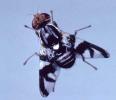|
Researchers are
continually looking for ways to control pests without using synthetic
pesticides. Biological, cultural or physical control measures would
(ideally) be less costly to both the environment and the pocketbook. One
area where significant progress is being made is with insect control in
the apple orchard.
|
 |
 |
 |
| Apple Maggot |
Plum Curculio |
Codling Moth |
Three major insect pests account for most of the damage
done to apples. The adult apple maggot is a clear winged fly which lands on
the fruit and lays its eggs. The infested apple becomes irregular and
"lumpy" and small larvae may be found inside. The plum curcullio leaves a
crescent shaped scar on the fruit where it lays its egg. Again, a little
worm is found inside. Codling moths also lay eggs on the surface of the
fruit. Their larvae are the little worms that are found near the seeds at
the center of the fruit. The majority of insecticide applications currently
used on apple orchards are to control these three pests.
 Scientists have discovered that the females of many insect
species attract males by emitting a strong chemical scent called a
pheromone. The pheromones of many insects including the codling moth have
been isolated and can be reproduced in the laboratory. Scientists have discovered that the females of many insect
species attract males by emitting a strong chemical scent called a
pheromone. The pheromones of many insects including the codling moth have
been isolated and can be reproduced in the laboratory.
A very small amount of this substance will attract males
from long distances. Researchers began to wonder what would happen if an
area were saturated with pheromone. They conducted experiments in which
plastic "twist tabs" were impregnated with the pheromones and hundreds of
the tabs were placed on trees in the test orchards.
They found that the poor confused male moths flew
frantically from tree to tree in search of females but found only
indifferent pieces of plastic. Eventually, the males gave up and mating did
not occur. The females had few fertilized eggs to lay on the fruit so damage
was greatly minimized.
 Preliminary results have been encouraging but there are
still problems to overcome. This process called, mating disruption, only
works on the codling moth and does nothing for the other major pests. It is
more expensive than conventional spray programs. Also, they discovered that
some secondary pests such as leaf rollers became a greater problem since
they hand normally been controlled as a by product of spraying for codling
moth. Preliminary results have been encouraging but there are
still problems to overcome. This process called, mating disruption, only
works on the codling moth and does nothing for the other major pests. It is
more expensive than conventional spray programs. Also, they discovered that
some secondary pests such as leaf rollers became a greater problem since
they hand normally been controlled as a by product of spraying for codling
moth.
Progress is being made with trapping for apple maggot but
plum curcullio is proving more difficult to control with alternative
approaches. Research continues. |



